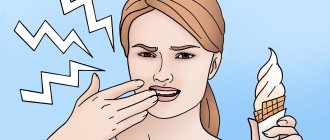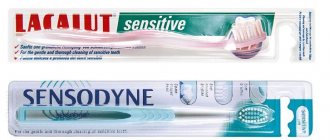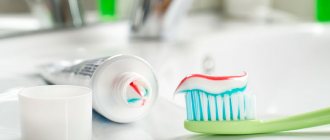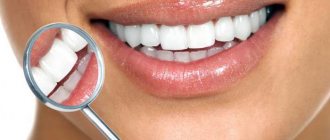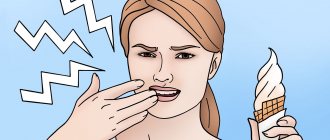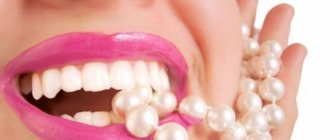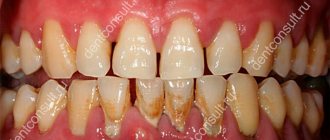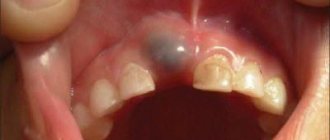Updated: 04/22/2021 15:47:27
Expert: Elizaveta Rubinstein
*Review of the best according to the editors of expertology.ru. About the selection criteria. This material is subjective in nature, does not constitute advertising and does not serve as a purchase guide. Before purchasing, consultation with a specialist is required.
People with sensitive enamel know firsthand how much pain eating hot/cold food or even regular daily teeth brushing can cause. They develop a constant fear that such habitual actions will cause a new wave of strong painful sensations. All this happens when dentin is exposed.
The hard tissue of the tooth is dotted with miniature canals leading to the nerve of the tooth. When the root part of the tooth is exposed or the enamel is damaged, the nerve endings are more easily excited by any external stimuli. If your enamel becomes very sensitive, the first thing you should do is make an appointment with your dentist.
After a professional examination, the doctor will give individual, practical recommendations for oral care. He will also prescribe a special toothpaste from the Sensitive category, which gently cleanses and relieves pain. This review will look at the best toothpastes for sensitive teeth from imported and Russian manufacturers.
Causes of the problem:
- Violation of the integrity of tooth enamel during chemical whitening;
- Frequent consumption of acidic foods;
- Lack of vitamins, minerals and trace elements in the body;
- Inflammatory process of the gums;
- Tartar removal;
- Erasure of enamel;
- Grinding the tooth for crown installation;
- Inflammatory process in the oral cavity;
- Eating hot foods together with cold ones;
- Malocclusion;
- Poor oral hygiene;
- Unbalanced diet;
- Smoking.
Reasons for the development of hypersensitivity
Tooth enamel itself is not a sensitive structure. It is designed to protect the soft tissues of the tooth from external factors. Enamel has increased strength because it consists of 96% mineral components. Under the enamel there is dentin with numerous nerve endings. It is he who is sensitive to external stimuli.
If the integrity of the enamel is compromised or it becomes thinner, then exposed dentin begins to provoke severe pain. But sometimes the integrity of the protective shell is preserved, but hyperesthesia is still present. The strength of pain in each person depends on the number of tubules piercing the dentin and the diameter of their lumen. Pain also matters.
Factors contributing to the appearance of hypersensitivity:
- Excessive use of whitening toothpastes.
They usually have a high index (RDA). At high levels, the abrasive particles are very large. If the RDA is 150 or higher, then this paste can be used only once a week so as not to thin the enamel.
- Frequent consumption of sugary sodas and packaged juices
. They usually contain a lot of sugar, acids and carbon dioxide. Such components make the protective shell of the tooth porous.
- Using aggressive home whitening products.
Damage to the enamel occurs in most cases.
- Poor oral hygiene.
Plaque and tartar are deposited on the enamel. Pathogens that cause caries and live in these deposits produce organic acids that destroy tooth enamel. As a result, hypersensitivity develops and caries occurs.
- Visiting a dental hygienist.
Typically, the phenomenon of hypersensitivity in this case is short-lived. It occurs due to the fact that in the areas where the stone was there is a lack of sufficient minerals. The problem in this case is solved by applying remineralizing compounds.
- Dietary errors.
If the diet is unbalanced and lacks vitamins A, D, C, group B, as well as minerals (calcium and phosphorus), then the enamel noticeably suffers.
- Improper brushing of teeth.
Due to performing only horizontal movements during daily oral hygiene, a wedge-shaped defect may develop (destruction of hard tooth tissue in the cervical area).
- Hypersensitivity also develops in people
having the habit of consuming cold and hot food or drinks at the same time. As a result, microcracks appear on the enamel.
Review of the best toothpastes
Toothpaste must be chosen not only based on advertising and cost, but also on the components of the composition. The safety of your teeth and gums depends on it.
- LACALUT Extra Sensitive.
This pasta takes an honorable first place and there is an explanation for this. It is of German production and quality. It contains beneficial active ingredients. They strengthen tooth enamel and reduce sensitivity. Pain sensations are reduced.
- PRESIDENT Sensitive.
This pasta is made by an Italian company. It contains less fluoride. However, it is also effective and in good standing. Its active components are the necessary substances. Potassium nitrate affects nerve endings, thereby reducing their sensitivity and reducing negative sensations. Sodium fluoride helps strengthen enamel. Hydroxyapatite nourishes the enamel with calcium and activates its resistance to temperature. A low level of abrasiveness allows you to efficiently remove plaque without damaging the enamel.
- SENSODYNE F.
This is an English-made paste in which the active ingredients are sodium fluoride and zinc. It has a healing effect and restores damaged enamel, reduces the sensitivity threshold. This is an excellent option for an inexpensive but effective paste. Of course, the effect will be smaller than the leaders, but nevertheless it will be there.
- SILCA Complete Sensitive.
This is a budget option when dealing with sensitivity. Contains medicinal substances. They block calcium leaching and neutralize acids. With constant use, the level of hyperesthesia decreases.
The best imported toothpastes for sensitive teeth
Consumers can easily purchase such products from Italian, German or Polish manufacturers.
Biorepair Sensitive Teeth Plus
Rating: 4.9
Biorepair Sensitive Teeth Plus toothpaste, made in Italy, has a very low level of abrasiveness - RDA 14.7. The product contains the maximum amount of hydroxyapatite microcrystals, which form dentin and enamel. It contains no fluorine, parabens, SLS, or titanium dioxide.
Biorepair Sensitive Teeth Plus has a classic application. It is enough to squeeze a small pea of the product onto your toothbrush and clean your teeth in a circular motion for 2-3 minutes. Thanks to the unique formula of this product, microcracks and micropores on the enamel surface are effectively filled. A special layer is also formed that protects the enamel from the effects of acids.
According to reviews, Biorepair Sensitive Teeth Plus lives up to all the manufacturer's promises. Consumers note that this paste is good at relieving tooth sensitivity and remineralizing enamel. Many people like that this cleanser is economical, has a pleasant taste and does not foam much. But since the paste has very low abrasiveness, to maintain hygiene at a decent level, it must be alternated with others.
Advantages
- liquid enamel in the composition;
- abrasiveness level - RDA 14.7;
- significantly reduces tooth sensitivity;
- regenerates enamel;
- does not contain harmful chemical components;
- economically used.
Flaws
- For complete cleansing, you need to alternate with other pastes.
Recommendations for use
It is important not only to choose the right paste, but also to use it correctly. To do this, you need to consult a dentist, who will examine the oral cavity and give appropriate recommendations. There are rules that must be followed:
- Do not expect a quick and strong effect from using toothpaste. It is necessary to brush your teeth daily for at least a week until you get the first results;
- When brushing your teeth, the paste should not be washed off immediately, but held on for a while so that the effect is stronger;
- You should not constantly brush your teeth with special toothpastes. The paste does not clean the stone 100%, as it has a low level of abrasiveness;
- The product has an analgesic effect, and you can easily miss the signs of emerging pathology in the oral cavity;
- Limit sour foods.
Why do the necks of teeth become exposed and how to restore gums?
Quite often, patients come to me with complaints of increased tooth sensitivity. It is impossible to drink cold water in the summer without eating ice cream.
Typically, gum recession is to blame. Let's figure out what it is and what can and should be done to enjoy delicious ice cream without discomfort.
Gum recession is the exposure of the neck of the tooth, which is accompanied by aesthetic discomfort and increased sensitivity.
Why does gum recession occur?
Gum recession occurs for many reasons.
The main reasons for a recession are:
- Hygiene. Plaque and tartar that are not removed in a timely manner lead to “squeezing” of the gums and exposure of the neck of the tooth. Also, overly aggressive poor home hygiene leads to the same consequences.
- Pathological bite. When the tooth is positioned incorrectly, when the tooth is tilted in one direction or another, or when there is severe crowding, the periodontium (the complex of tissues surrounding and holding the tooth) is overloaded, which leads to a reduction in the gums and exposure of the tooth root.
Treatment of gum recession.
A very important point is that during recessions, not only gum loss occurs, but also loss of BONE TISSUE in the tooth area. Based on this, if you do not pay attention to this problem in a timely manner, it can lead to further mobility and loss of teeth.
Surgery is the main treatment for gum recession. Thanks to different techniques, the gingival contour is restored and the tooth root is closed.
If the cause of recession is associated with a pathological bite, then in such a situation it is necessary to first carry out orthodontic treatment and, after completion, resort to surgical methods.
In some cases, with proper orthodontics, the recession is closed without resorting to surgery.
Gum recession classification.
Depending on the severity of the current, recessions occur
- Mild form - the gums recede no more than 3mm.
- Medium shape - the gums drop by 3-5mm.
- Severe form – the gums recede by more than 5mm.
With regards to the coverage of the oral cavity, the pathology can have both local and generalized distribution.
Treatment of gum recession.
The main essence of the surgical technique is taking your own tissue (from the palate or the tubercle of the upper jaw) and suturing it in the defect area, thereby increasing the volume of soft tissue.
The relevance of this technique remains in both localized and generalized forms. Its advantage is considered to be effective restoration, since the materials are 100% identical. The only drawback of the manipulation is the feeling of slight discomfort for some time at the site of donor tissue collection. There are also cases when the flap does not take root in the transplanted area. As a rule, this happens due to poor hygiene and failure to follow the recommendations given by the doctor.
A favorable prognosis ensures timely seeking qualified help. Therefore, you should not put off your visit to the dentist, since the outcome of treatment depends on this.
How to stop gum recession!
- if there are dental diseases and other injuries to the oral cavity, then it is necessary to treat them in a timely manner - this applies to a greater extent to caries, which patients often bring to an advanced state (becomes complicated forms);
- regularly visit the dentist for a preventive examination: as you know, early diagnosis allows you to quickly eliminate the problem, without radical intervention, without waiting for serious health problems;
- monitor the condition of the gingival margin, avoiding injury and excessive bleeding;
- correct the bite in a timely manner;
- do not forget about strengthening tooth enamel with the help of remineralizing treatment;
- pay special attention to hygiene - effective brushing of teeth, choice of brush and toothpaste.
One of my works:
Preparation (closure of recession) was carried out before orthodontic treatment. After orthodontic treatment, cosmetic removal of remaining recessions is planned.
How to choose pasta
- Abrasiveness
This is the first parameter that deserves attention. In case of hypersensitivity, the RDA should be in the range from 20 to 50. For comparison: for classic toothpastes, designed for teeth without any special problems, the RDA index is on average 75, and for whitening pastes it is above 100.
- Compound
- an equally important parameter. The following components are usually used in pastes to eliminate hyperesthesia:
- Potassium nitrate, potassium chloride
. The tasks of these components are to block the transmission of nerve impulses. Their clear advantage is that they quickly eliminate pain. But at the same time, the cause of hyperesthesia does not go away. The substances act only at the time of application of such a paste.
- Calcium hydroxyapatite, zinc citrate, strontium chloride, fluorides.
The listed substances clog the thin tubules that penetrate the dentin. And strontium chloride also compacts the dentin structure. But the effect of such components cannot be called instantaneous.
- Calcium carbonate supplemented with arginine
. The openings of the dentinal tubules are blocked. Although such components reduce sensitivity, they do not restore the damaged structure of the protective shell of the tooth.
Taking into account the fact that some components have an immediate effect, while others have a prolonged effect. The most effective pastes usually have a combined composition.
